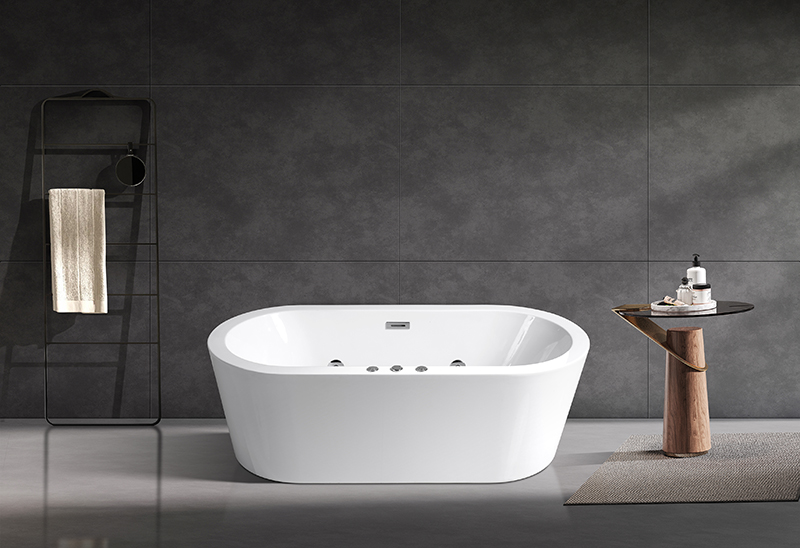MV-X195 304 Stainless Steel Thermostatic Shower Panel
Model:MV-X195 Dimention:100X185(mm) Material:Stain...
Considering the long-term maintenance costs and energy consumption of massage bathtubs is essential to making an informed purchase decision. Here’s a detailed breakdown of these aspects:
Long-Term Maintenance Costs
Regular Cleaning:
Cleaning Products: Cost of specialized cleaning agents for the tub’s surface, jets, and internal plumbing to prevent mold, mildew, and calcium buildup.
Frequency: Regular cleaning might be required weekly or monthly, depending on usage.
Component Maintenance and Replacement:
Jets and Pumps: Over time, jets and pumps may require cleaning, repair, or replacement. Costs can vary depending on the brand and complexity of the parts.
Seals and Gaskets: These components may wear out and need periodic replacement to prevent leaks.
Electronic Controls: Digital control panels and electronic components might need servicing or replacement.
Professional Servicing:
Annual Inspections: Hiring professionals for annual maintenance checks to ensure all components are functioning correctly.
Repairs: Unexpected repairs due to malfunctions or wear and tear can add to the maintenance costs.

Water Treatment:
Chemical Treatments: Costs for water treatment chemicals to maintain water quality and prevent bacterial growth.
Filtration Systems: Regular replacement or cleaning of filters.
Energy Consumption
Heating:
Water Heaters: Massage bathtubs often have built-in water heaters to maintain desired temperatures. These can be a significant source of energy consumption.
Energy Efficiency: Choosing a model with an energy-efficient heater can reduce long-term energy costs.
Pumps and Jets:
Electricity Use: The pumps and jets used for hydrotherapy can consume a considerable amount of electricity, especially with frequent use.
Variable Speed Motors: Models with variable speed motors may offer more energy-efficient options for different massage settings.
Insulation:
Thermal Insulation: Tubs with better insulation retain heat more efficiently, reducing the energy required to maintain water temperature.
Covers: Using insulated covers when the bathtub is not in use can help retain heat and reduce energy consumption.
Ways to Minimize Costs and Consumption
Energy-Efficient Models:
Opt for massage bathtubs with energy-efficient certifications or ratings. Look for features like high-efficiency pumps and heaters.
Scheduled Maintenance:
Regular maintenance can prevent costly repairs and ensure the bathtub operates efficiently. This includes periodic professional servicing and routine cleaning.
Usage Habits:
Limiting the duration and frequency of use can significantly reduce energy consumption and wear on components.
Turning off jets and pumps when not in use and using the heater only when necessary can save energy.
Advanced Technology:
Some modern bathtubs come with smart controls that optimize energy use, such as programmable timers and eco-modes.
Water Treatment Systems:
Invest in high-quality water treatment systems to reduce the need for frequent chemical use and ensure longer-lasting components.
When considering the purchase of a massage bathtub, it’s crucial to factor in long-term maintenance costs and energy consumption. By selecting energy-efficient models, adhering to a regular maintenance schedule, and being mindful of usage habits, you can manage these costs effectively and enjoy your bathtub without unexpected expenses.

Model:MV-X195 Dimention:100X185(mm) Material:Stain...

Model:MV-L692 Dimention:1500X150(mm) Material:Alum...

Model:MV-H308B Dimention:1500X200(mm) Material:Sta...

Model:MV-G8005A Dimention:1500X200(mm) Material:St...

Model:A001 Dimention:1700X850X620(mm) Function: wh...

Model: A-20P-1N 80*190(cm) 90*190(cm) 100*190(cm) ...

Model: A3121 70*90*190(cm) 80*80*190(cm) 90*90*190...

Model:MV069D-1 White Dimension: 67X31.5X22.8 inch ...